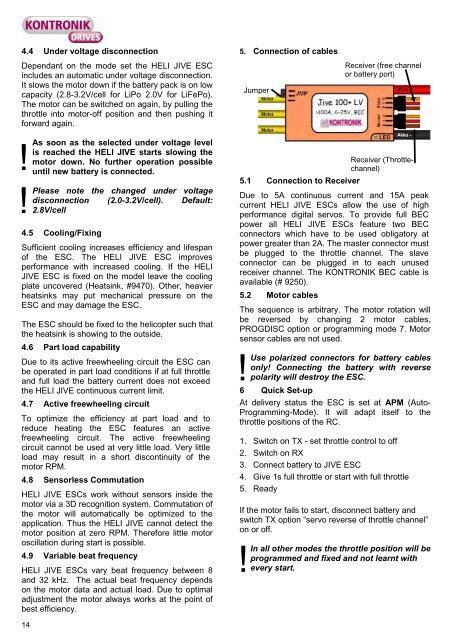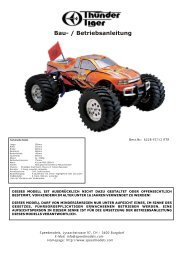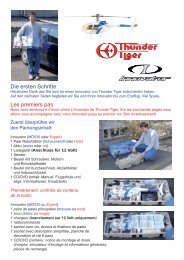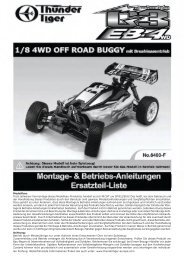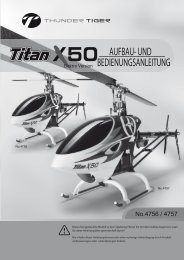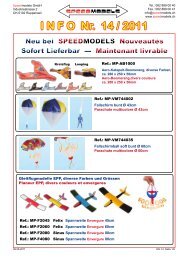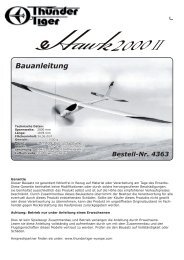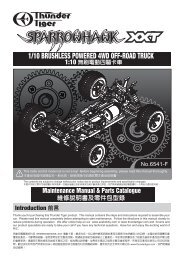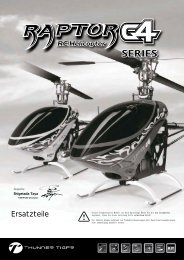HELI JIVE Regler Bedienungsanleitung + HELI JIVE ... - Speedmodels
HELI JIVE Regler Bedienungsanleitung + HELI JIVE ... - Speedmodels
HELI JIVE Regler Bedienungsanleitung + HELI JIVE ... - Speedmodels
Sie wollen auch ein ePaper? Erhöhen Sie die Reichweite Ihrer Titel.
YUMPU macht aus Druck-PDFs automatisch weboptimierte ePaper, die Google liebt.
4.4 Under voltage disconnection<br />
Dependant on the mode set the <strong>HELI</strong> <strong>JIVE</strong> ESC<br />
includes an automatic under voltage disconnection.<br />
It slows the motor down if the battery pack is on low<br />
capacity (2.8-3.2V/cell for LiPo 2.0V for LiFePo).<br />
The motor can be switched on again, by pulling the<br />
throttle into motor-off position and then pushing it<br />
forward again.<br />
!<br />
!<br />
14<br />
As soon as the selected under voltage level<br />
is reached the <strong>HELI</strong> <strong>JIVE</strong> starts slowing the<br />
motor down. No further operation possible<br />
until new battery is connected.<br />
Please note the changed under voltage<br />
disconnection (2.0-3.2V/cell). Default:<br />
2.8V/cell<br />
4.5 Cooling/Fixing<br />
Sufficient cooling increases efficiency and lifespan<br />
of the ESC. The <strong>HELI</strong> <strong>JIVE</strong> ESC improves<br />
performance with increased cooling. If the <strong>HELI</strong><br />
<strong>JIVE</strong> ESC is fixed on the model leave the cooling<br />
plate uncovered (Heatsink, #9470). Other, heavier<br />
heatsinks may put mechanical pressure on the<br />
ESC and may damage the ESC.<br />
The ESC should be fixed to the helicopter such that<br />
the heatsink is showing to the outside.<br />
4.6 Part load capability<br />
Due to its active freewheeling circuit the ESC can<br />
be operated in part load conditions if at full throttle<br />
and full load the battery current does not exceed<br />
the <strong>HELI</strong> <strong>JIVE</strong> continuous current limit.<br />
4.7 Active freewheeling circuit<br />
To optimize the efficiency at part load and to<br />
reduce heating the ESC features an active<br />
freewheeling circuit. The active freewheeling<br />
circuit cannot be used at very little load. Very little<br />
load may result in a short discontinuity of the<br />
motor RPM.<br />
4.8 Sensorless Commutation<br />
<strong>HELI</strong> <strong>JIVE</strong> ESCs work without sensors inside the<br />
motor via a 3D recognition system. Commutation of<br />
the motor will automatically be optimized to the<br />
application. Thus the <strong>HELI</strong> <strong>JIVE</strong> cannot detect the<br />
motor position at zero RPM. Therefore little motor<br />
oscillation during start is possible.<br />
4.9 Variable beat frequency<br />
<strong>HELI</strong> <strong>JIVE</strong> ESCs vary beat frequency between 8<br />
and 32 kHz. The actual beat frequency depends<br />
on the motor data and actual load. Due to optimal<br />
adjustment the motor always works at the point of<br />
best efficiency.<br />
5. Connection of cables<br />
5.1 Connection to Receiver<br />
Due to 5A continuous current and 15A peak<br />
current <strong>HELI</strong> <strong>JIVE</strong> ESCs allow the use of high<br />
performance digital servos. To provide full BEC<br />
power all <strong>HELI</strong> <strong>JIVE</strong> ESCs feature two BEC<br />
connectors which have to be used obligatory at<br />
power greater than 2A. The master connector must<br />
be plugged to the throttle channel. The slave<br />
connector can be plugged in to each unused<br />
receiver channel. The KONTRONIK BEC cable is<br />
available (# 9250).<br />
5.2 Motor cables<br />
The sequence is arbitrary. The motor rotation will<br />
be reversed by changing 2 motor cables,<br />
PROGDISC option or programming mode 7. Motor<br />
sensor cables are not used.<br />
!<br />
Use polarized connectors for battery cables<br />
only! Connecting the battery with reverse<br />
polarity will destroy the ESC.<br />
6 Quick Set-up<br />
At delivery status the ESC is set at APM (Auto-<br />
Programming-Mode). It will adapt itself to the<br />
throttle positions of the RC.<br />
1. Switch on TX - set throttle control to off<br />
2. Switch on RX<br />
3. Connect battery to <strong>JIVE</strong> ESC<br />
4. Give 1s full throttle or start with full throttle<br />
5. Ready<br />
If the motor fails to start, disconnect battery and<br />
switch TX option “servo reverse of throttle channel”<br />
on or off.<br />
!<br />
Jumper<br />
Receiver (free channel<br />
or battery port)<br />
Receiver (Throttlechannel)<br />
In all other modes the throttle position will be<br />
programmed and fixed and not learnt with<br />
every start.


